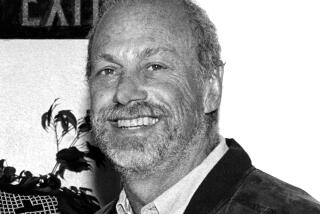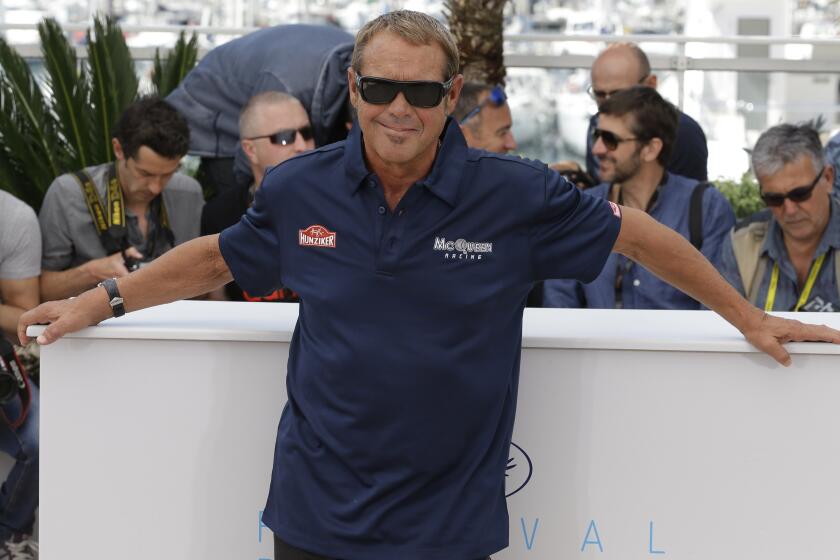Don Van Vliet dies at 69; avant-garde rock musician known as Captain Beefheart
Don Van Vliet, a maverick musician who emerged from the Southern California desert with the name Captain Beefheart and a singular and influential form of avant-garde rock in the 1960s, died Friday. He was 69.
Van Vliet, who retreated to a reclusive life as an abstract painter in the early 1980s, died from complications of multiple sclerosis at a hospital near his home in Trinidad in Northern California, said a spokeswoman for the Michael Werner Gallery, his New York-based art dealer.
Captain Beefheart and the Magic Band never sold many records, but their work was critically acclaimed, especially the epic, surreal 1969 album “Trout Mask Replica,” which was ranked No. 58 on Rolling Stone magazine’s list of the 500 greatest albums of all time.
Van Vliet’s creative vision exerted an influence on a wide range of musicians, including the White Stripes, Tom Waits, Devo, PJ Harvey, the Talking Heads and John Lydon. Avowed admirers include members of the Red Hot Chili Peppers and the Clash and “The Simpsons” creator Matt Groening.
“Back in my formative years, my buddies and I were looking for the furthest limits in pop music,” Groening, who helped reassemble the Magic Band to play the All Tomorrow’s Parties festival that he curated in Long Beach in 2003, said Friday.
“We loved avant-garde jazz, and we loved the blues, and Captain Beefheart melded them in a way that no one else has ever done, with the vocal techniques of Howlin’ Wolf on top of these crazy, angular songs.
“When I first heard ‘Trout Mask Replica,’ I thought it was a disorganized mess, I could not hear the structure … and it’s grown to be the album I most admire.... It really hasn’t been surpassed as an uncompromising artistic statement. In fact, after listening to Beefheart, everything else seems pretty tame.”
Waits, who was elected this week to the Rock and Roll Hall of Fame, learned from Van Vliet’s gravelly vocal approach and boundary-breaking spirit, and was one of the people with whom the singer spent hours on the phone during his post-music years.
“He was like the scout on a wagon train,” Waits wrote in an e-mail Friday. “He was the one who goes ahead and shows the way. He was a demanding bandleader, a transcendental composer (with emphasis on the dental), up there with Ornette [Coleman], Sun Ra and Miles [Davis]. He drew in the air with a burnt stick. He described the indescribable. He’s an underground stream and a big yellow blimp.
“I will miss talking to him on the phone. We would describe what we saw out of our windows. He was a rememberer. He was the only one who thought to bring matches. He’s the alpha and the omega. The high water mark. He’s gone and he won’t be back.”
Van Vliet was born Don Vliet (he added the “Van” as a young man) in Glendale on Jan. 15, 1941, and showed such a talent for sculpture that he was offered a scholarship to study in Europe. But his parents didn’t encourage his artistic leanings.
The family moved to Lancaster, where he found a high school classmate with a similar subversive sensibility and love of the blues and jazz: Frank Zappa.
Their collaborations eventually led to the 1964 formation of the first edition of Captain Beefheart and the Magic Band, which played local dances and developed a sound that showcased their leader’s gruff, powerful voice.
Their recording of Bo Diddley’s “Diddy Wah Diddy” for A&M Records was a hit on the new medium of underground FM radio, but the album they recorded proved too quirky for the label, which declined to release it.
Beefheart and company, joined by young slide guitar prodigy Ry Cooder, re-recorded the songs, and “Safe as Milk” came out on Buddah Records in 1967. Its experimental spin on traditional blues attracted a cult audience, but Van Vliet proved too prickly to cultivate a conventional career.
There were conflicts over the recordings that formed 1968’s “Strictly Personal,” and Van Vliet, who sang and played the saxophone, then hooked up with his old friend Zappa’s new company, Straight Records.
Zappa produced “Trout Mask Replica,” whose sound was forged during intensive, communal rehearsals in a Woodland Hills house, with Van Vliet exerting domineering control over his musicians in an atmosphere they described as “cult-like.” He gave them names such as Zoot Horn Rollo and the Mascara Snake, and they turned out a unique masterpiece.
If the record secured his artistic legacy, his free-spirited ways contributed to an erratic career path. Three early-’70s albums maintained his artistry, but commercial compromises marred his work in mid-decade. “Shiny Beast (Bat Chain Puller)” was a 1978 return to form, but “Ice Cream for Crow” marked the end of his musical career in 1982.
Frustrated by his experience in the music business, Van Vliet, who had always painted, moved out of Los Angeles and launched his art career in 1985, boosted by a prominent fan, artist Julian Schnabel. His work quickly gained recognition, and his income as a painter would soon far outstrip his recording proceeds.
“Part of why I stopped doing music was because it was too hard to control the other people I needed to play the stuff, and I’d had enough animal training,” he told The Times in 1990.
“When it comes to art, I have a real streak of fascism. I want it to be exactly the way I conceive it, and if one line is changed it’s like, ‘Hey, the hell with it, I don’t need it.’
“As far as my career in music, I think I’m in pretty good stead and that I did what I wanted to do — which is not to say I’m finished with music. The only thing that stops a composer from thinking about music is rigor mortis, and I still compose all the time. I work on my paintings, and while the paint is drying I’ll write a song. But I have no interest in making records anymore — I’m finished with that for good.”
“There are no other painters in America anything like Don,” his art dealer Michael Werner told The Times in 1990. “The way he handles space, the content of the work — the whole approach is unique, and he truly stands alone.
“He’s not connected with any school or movement, and he never looks at paintings, so in a sense he’s an outsider artist.... Mostly his work exists in a different universe. For me, that’s what makes him so important.”
“He was a very complex person,” journalist Kristine McKenna, a close fried of Van Vliet’s for 20 years, said Friday.
“He took great pleasure in a lot of things. Obviously, he was just built differently than the rest of us completely, just the way he experienced everything. He was very intuitive and very tuned in to the natural world. He loved animals, but he was kind of a misanthrope at the same time. He thought human beings were the worst species that was ever dreamed up, and he expressed that often in many different ways.”
Van Vliet is survived by his wife of more than 40 years, Jan.
Cromelin is a former Times staff writer.
More to Read
Start your day right
Sign up for Essential California for the L.A. Times biggest news, features and recommendations in your inbox six days a week.
You may occasionally receive promotional content from the Los Angeles Times.






